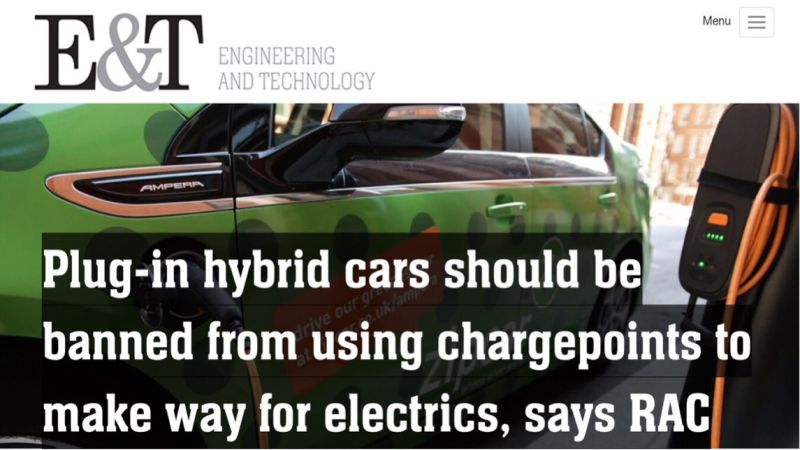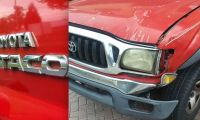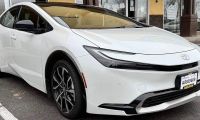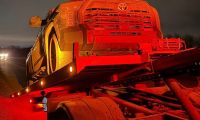It hasn’t been looking good for the PHEV lately as car manufacturers like Ford, even GM have cancelled a slew of them, even the storied iconic Chevrolet Volt, as GM, VW Group too, are switching supply chains and accelerating their plans even further to rid themselves of most of their gasoline cars in their portfolios in five years. But glaring problems with PHEVs are becoming even more obvious with the Electrify America build out and with Tesla’s network upgrade, if it ever becomes public, that complicates life for the PHEV: 5-40 minute supercharging is incompatible with PHEVs. Because of their older ECU and computer nodules that it takes twelve times as long to recharge a PHEV than a BEV at a supercharger, a push back is intensifying to ban them from supercharger networks in the UK. US car makers on this side of the lake and on the other end of the problem seem to have found another approach as a solution:
- Ford, now GM are cancelling PHEVs right through their portfolios.
- GM and VW Group are accelerating their plans to get rid of most of their gasoline cars. We should assume this also includes hybrids. Their 10 year plans are now 5 year plans, and are even looking more like ASAP.
- VW announced whatever is out there in gas production and coming right off the drawing board right now, is it for them. If it isn’t refreshed by 2026, its cancelled.
- Supercharger networks like Electrify America and Tesla are situated at strategic points along/around the US Eisenhower Interstate System in the US 49.
- Supercharger networks are meant for supercharger capable BEVs that can recharge in usually 30-40 minutes, more likely newer BEVs in as little as 5-10 minutes.
- PHEVs have older ECUs, engine control units, that’s the car’s brain, and accompanying electronic equipment, that would make a PHEV drip charge at a supercharger.
- That’s wasted time and money at a supercharger network, especially by the highway, and with a line waiting behind to recharge as well, a wasted space that could be done at Level 1 or 2 or home.
- ECUs are expensive and it doesn’t make sense to upgrade for only a 50 mile range.
- The RAC, the UK’s AAA, is making a ban recommendation in the UK.
- With what car manufacturers are already doing to their PHEVs here, the writing is on the wall . . .
As the nation’s some 14 charger networks continue their sojourn of proliferating new stations and chargers while some upgrade their superchargers, car makers around the globe are ramping up their factories and switching supply chains to get ready for the massive incursion of battery electric vehicles coming, the first onslaught in 2019, the electric tsunami, in 2020. You would think that it would be counterintuitive for a carmaker to slay a hybrid from their portfolio, but that’s exactly what GM, even Ford, a company that hasn’t done well with electric cars so far, are doing.
The latest technology being installed into supercharging networks allow supercharging capable BEV only vehicles to recharge 80% of their range in as little as 5-10 minutes. That means an empty pack whose battery went dead can recharge in 5 minutes and get 15 miles of range. Because of older technology hybrid vehicles being incompatible with this new technology with their ECU and computer control nodules, this process would take much longer to achieve the same result.
Based on a report given to trade publication Engineering and tTechnology, “However, because of the limitations of their on-board control units, it will take almost all plug-in hybrids an hour or so – twelve times as long – to achieve a similar result. This mismatch means that expensive, high-specification equipment which is essential to battery-only vehicles on long journeys could be blocked by other, slower-charging vehicles.” Those slower-charging vehicles also have much shorter ranges. Even for short range BEVs like the Nissan Leaf, double supercharging on the same trip is not recommended which would lead to another form of drip charging in fail safe mode, as the batteries become way too hot to handle both highway speeds and immediate supercharging.
The RAC, which is the US equivalent to the AAA, and from which AAA members can redeem reciprocal benefits, recently recommended banning them from supercharger stations in the UK. Speaking to a magazine Engineering and Technology, RAC Foundation director Steve Gooding said: “Ever-faster and more powerful chargepoints might sound like the answer to creating the electric car recharging network we need, but if the cars themselves can only be recharged at a certain rate then at best we’re going to be disappointed and at worst we’re going to waste money. Compatibility between car and charger is key.”
Since the inception of the electric car revolution in 2008 with the factory roll out of the Tesla Model S, not one non-compliant battery electric car in the US by any car manufacturer has been cancelled in production since. Manufacturers have canceled scores of hybrids.
Banning PHEVs? What do you think? Let us know below!













Comments
It is an awkward transition
Permalink
It is an awkward transition time for American automakers, moving towards additional electrification of their vehicles. For several decades now American automakers have struggled to make a decent profit from smaller, economy cars. And even though they make good money from gas guzzling trucks and SUVs there are federal and state mandates for improving fuel economy and smog output. The latest move by GM and Ford to cut many of their small cars and sedans, and effectively giving that market to Japanese and European rivals is an unfortunate trend that we have seen before in the U.S. But that move needs to have electrified cars that use little or no gas to compensate for the profitable gas guzzlers. What you are seeing as an elimination of PHEVs is actually a shift to hybrid, PHEV, and BEV versions of bigger vehicles. Ford's official announcement of their plans for electrification from May of this year by Ford president, Jim Farley are:
“We’re also going big on hybrids.”
“They will bring new capability and emotion to our highest volume and most profitable vehicles. They will also protect our customers against higher gas prices.”
“The company plans to have a hybrid for every model of car or truck sold in North America.”
“Hybrids for years have been mostly niche products but are now on the cusp of a mainstream breakout.”
“Every time we launch a utility (SUV or crossover) in North America, our intention is to have a hybrid.”
“Today, Ford Motor Company is the number-two seller of hybrids in the U.S., and in 2021 we expect to surpass Toyota Motor Corp. to be number one. We’re going to do this by making hybrids mainstream with our highest-volume, most profitable vehicles.” And GM's plans for electrification are bolder. In Oct. 2017 General Motors announced plans to launch two new all-electric cars over the next 18 months (by 2020), as well as 20 new EVs by 2023.
But to free up money for those BEVs GM is laying off 12,000 employees and closing two factories, discontinuing the Chevy Cruze (31,971 Q3 sales), Impala (16,290), and Volt (5,429), the Buick LaCrosse (2,290), and the Cadillac XTS (4,101) and CT6 (2,281). Of these, both the Volt and XTS actually had increasing sales in Q3, which shows that GM's claims of declining sales for the Volt are false.
The Cruze, even with a 27% decrease in sales, was still Chevy’s fifth best selling model, and it accounted for over 6% of all Chevys sold. From GM's announcements so far they are only going to bring two new BEVs to market next year, and they are cutting the Volt. It's not really a revolutionary move, but they are already getting a LOT of criticism for cutting American jobs. I suspect that (like Ford) GM will modify several models to be hybrids and PHEVs to meet fleet gas mileage requirements over the next couple years, but they can't really announce that they are going to sell hybrid/PHEV SUVs now, just as they are cutting the Volt, as it will look even worse for them. It is true that existing PHEVs, and most older BEVs do not offer fast charging, but managing the limited EV charger availability is a whole other problem. One that will be hopefully helped as more chargers get installed, and new PHEV models get fast charging capability. It is quite possible that a new PHEV with a 50 mile range could get an 80% fast charge in 5 minutes. I do not think that PHEVs are going away to make room for BEVs. I see hybrids, PHEVs, and BEVs all growing in a larger electrified automobile market, where pure gas/diesel cars (that currently make up 95% of new car sales) will be augmented with hybrid models, new PHEV models, and a growing number of BEV models, but slowly, over the next 5 years.
Dean I’m not going to waste
Permalink
In reply to It is an awkward transition by DeanMcManis (not verified)
Dean I’m not going to waste time what you cannnot see as writing on the wall. I’m paid to look at the bigger picture and I think I’m serving my readership well and my track record predictions have proven so. GM cancelled Volt and a slew of other PHEVs, more to come, including ones planned for production. Expect the same from VW Group. Farley statements you quoted are before the VW deal. Things have changed for Ford and VW will help them fully electrify. New supply chains make it much more expensive now to make PHEVs and the tech makes it incompatible with updated mega supercharging. Have you not read? Fast mega supercharging a PHEV with a 50 mile range is silly, a waste of time, DANGEROUS as the battery is small, yes dangerous to mega charge a tiny battery, and frankly, inconsiderate to BEV owners waiting for a charge. Go home and plug it in where it belongs. Enough of this. You’re becoming a Titanic victim holding onto the rail at hour !:40, and seconds from foundering when no more options are left, thinking there’s some. There ain’t! PLEASE I need for you to engage me elsewhere where your knowledge and talents lay, not here with these silly PHEVs. Please let this go. LET THIS GO. Thanks anyway.
Readers: the PHEV is dying,
Permalink
Readers: the PHEV is dying, it is outdated, and now expensive to make, and to upgrade, and to integrate. The technology is now OBSOLETE. Please, I love you all, but this is about NO EMISSIONS, not LOW. And now, it has become more cheaper and faster to make a BEV than it does any kind of gasoline car, including a PHEV, which is what that is. The argument is moot. Lets move on please.
The argument is only moot to
Permalink
The argument is only moot to you because you stick to a BEV-or-nothing attitude, but you cannot argue against the fact that well over 90% of the new cars sold are ICE/gas cars and trucks today. You like to propose the idea that automakers are going to leap past hybrids and all go to BEVs, but the truth is that there are some serious gaps between the cheap, long range BEVs and robust fast charging network of EV stations, and today's lack of fast chargers and cheap, long range EVs. Sure, VW is moving quickly on both fronts, and GM has said that they will be building many new BEVs. But I believe that the transition is longer than you will admit. And I have to address your comment about fast charging a smaller battery being dangerous because it is untrue. I hope that you understand that all automotive traction batteries are actually collections of smaller cells. Bigger battery packs have more cells, but they still are actually the same smaller cells inside. The enemy of long battery life and safety is heat, and batteries charged past 80% of their full capacity produce more heat after 80%, which is why big battery packs slow their charge as they approach being full, especially with fast charging. But with PHEVs like the Volt their 51+ mile maximum range is reached at 80% battery charge (full is 80%) as GM engineered that consideration into their design. It is idealistic that you think that all automakers will jump straight to BEVs, but with the majority of them barely crawling towards EVs, I would be surprised to see more than 10% BEV sales overall in the next 3 years, although I expect hybrid models to increase more.